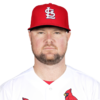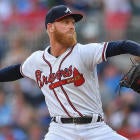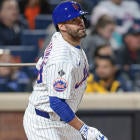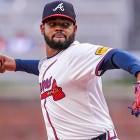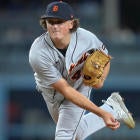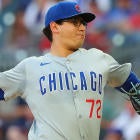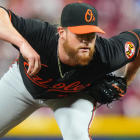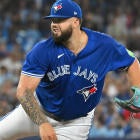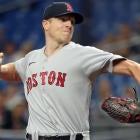Want more sleepers for your Fantasy draft? Head to SportsLine.com and check out the all-new ACES metric to find overlooked starting pitchers. You'll find some names from this list ranked surprisingly high.
Regression comes in many forms, especially when you're talking about Fantasy sports. Sometimes we're talking about good or bad luck that was largely out of the player's control. Other times we're just talking about a player regressing back to the player he was before a career year.
Regardless of what's implied by the term, the most important thing for a Fantasy owner to know is which players are expected to have different results in 2019 and why. Here are six pitchers due for regression and what you should expect this season.
Jon Lester has already been named the Opening Day starter for the Cubs. And why not? He won 18 games last year and posted a very good ERA. That's an ace, right? Actually, he's far from it.
Lester's 19.6 percent strikeout rate in 2018 was tied with Jhoulys Chacin for 43rd out of 57 qualified major league starters. It was worse than Matthew Boyd and Jake Odorizzi. His swinging strike rate (8.5 percent) was even worse, ranking 49th behind Jose Urena and Mike Fiers. Now, you can get away with that if you have great control like Miles Mikolas, but Lester's walk rate (8.4 percent) was the 16th highest amongst qualified starters.
This all helps explain why the peripherals for Lester looked so bad. He had a 4.39 FIP and a 4.57 SIERA. What's maybe even more damning is that the 18 wins don't even make sense. He averaged less than six innings per start for the second year in a row and only had six starts all year where he lasted seven innings.
Every metric we have shows Lester as a mediocre starter. Unless he gets very fortunate again in 2019, he may not even be must-start.
Kyle Freeland is simply a weird pitcher. Rules don't apply to him. That's a take I'd have a hard time arguing with at this stage of his career, but I'm here to call for regression for at least one more year anyway.
What makes him so weird? Well, he pitches for the Rockies and his career home ERA (3.04) is far better than his career road ERA (3.75). Even weirder? He posted a 2.85 ERA despite a K/9 below eight and BB/9 above three. He was just the 10th pitcher to do that in the past 10 years. Maybe more importantly, no pitcher has done it more than once in the past 20 years. It's largely a list of pitchers who weren't nearly as good the following year.
Of course, you can regress a long way from a 2.85 ERA and still be good, so we should talk about how much regression to expect. Freeland's FIP was 3.67, and that's plenty good. His 4.22 xFIP not so much. His SIERA was even worse at 4.35. How was he so much better than expected? He stranded 82.8 percent of runners who reached base. League average is 72.8 percent. He gave up a .285 BABIP, 10 points better than league average. What was more outlandish was the .269 home BABIP-against in a park that allowed .325 in 2018.
It's not just that Kyle Freeland is going to be worse than he was in 2018. He's probably not going to be worth rostering.
I wrote plenty about Mike Foltynewicz in my bust column last month, so I'll keep this shorter. His BABIP-against was 52 points lower than his career average, his 77 percent strand rate was four points higher and his 9.6 percent HR/FB rate was a full two points below. That's why his SIERA was nearly a full point higher than his ERA. Now, he can still be a serviceable starter at the back end of your staff if he pitches to his peripherals, but he won't be worth his current draft cost.
Speaking of players I've written plenty about, Nick Pivetta everyone! You might think there are only so many ways I can say that he's going to be good this year. You'd be wrong. I've got several left. Pivetta had the 13th best SIERA among qualified starters last year. He was tied for 13th in xFIP and K-BB percentage. He had the second biggest gap between his ERA and his FIP.
Pivetta gets whiffs and ground balls. He doesn't have control issues. I fully expect his strand rate, BABIP-against and HR/FB rate will all improve this season and he'll be a top-35 starting pitcher.
Like Pivetta and Foltynewicz, I've written a lot about Shane Bieber, but there's a lot to like. As a rookie he had a 46.5 percent ground ball rate, a 24.3 percent strikeout rate and a 4.7 percent walk rate. For comparison's sake, that's a similar ground-ball rate to Jameson Taillon with more strikeouts and fewer walks. A 69 percent strand rate and a .356 BABIP-against derailed Bieber's ratios, but I wouldn't expect that to continue in 2019.
We're talking about a pitcher who should approach 190 innings with good ratios and close to a strikeout per inning. Oh yeah, he pitches for a team that's expected to win more than 90 games. Bieber has legitimate top-20 potential this season and doesn't have to change much to reach it.
Edwin Diaz was phenomenal last year. In fact, he was even better than his peripherals. His SIERA, FIP and xFIP were all lower than his ERA. So what kind of regression nonsense is this? The reliever kind.
The nasty secret about relievers is that we don't get a big enough sample size in one season to know for sure how real their performance was. Diaz has thrown as many innings in his career (191) as some starters throw in one season. And last year was a bit of an outlier in that career. He set a career best in both walk and strikeout percentage. His WHIP was 0.36 better than his career best before 2018. And then of course we get to the saves.
At the very least you shouldn't expect Diaz to come anywhere close to last year's saves mark (57). That seems obvious, but the fact that Diaz is being drafted a full round before any other closer makes me think it's not.
He'll likely be very good, maybe even great. But the likelihood he'll be the best closer in baseball, or even top three, isn't high enough to draft him where you have to.
So which Fantasy Baseball sleepers should you snatch in your draft? And which undervalued pitchers can help you win a championship? Visit SportsLine now to get Fantasy Baseball rankings for every single position, all from the model that called Scooter Gennett's huge breakout last season, and find out.







